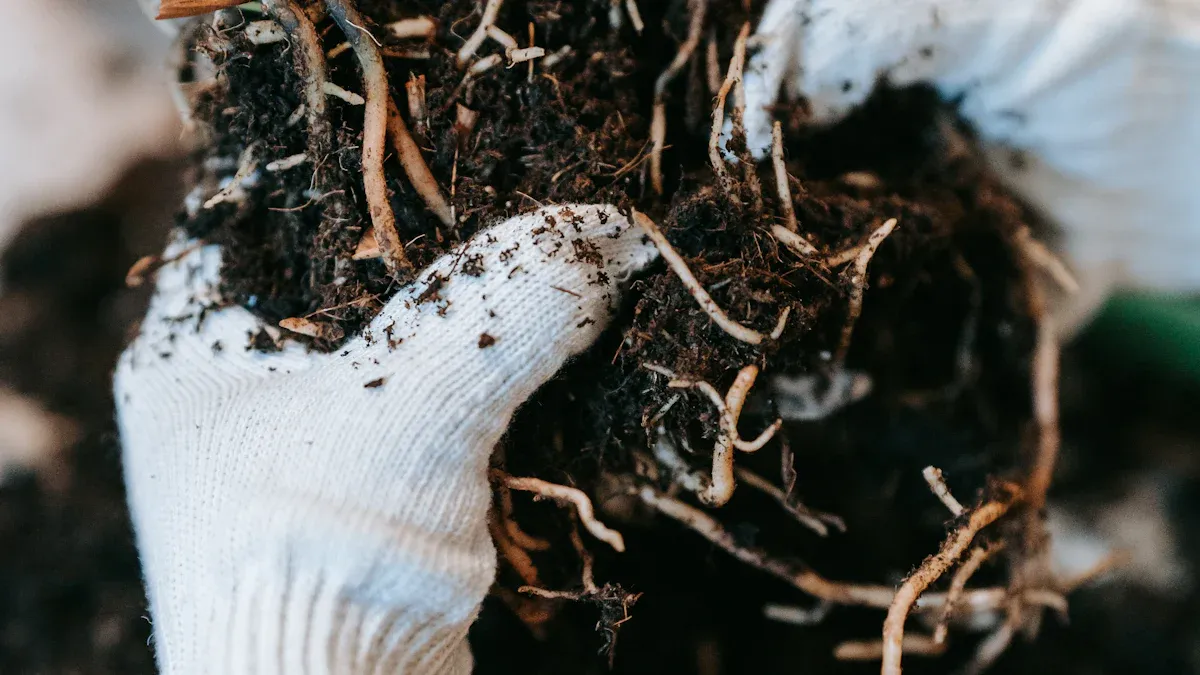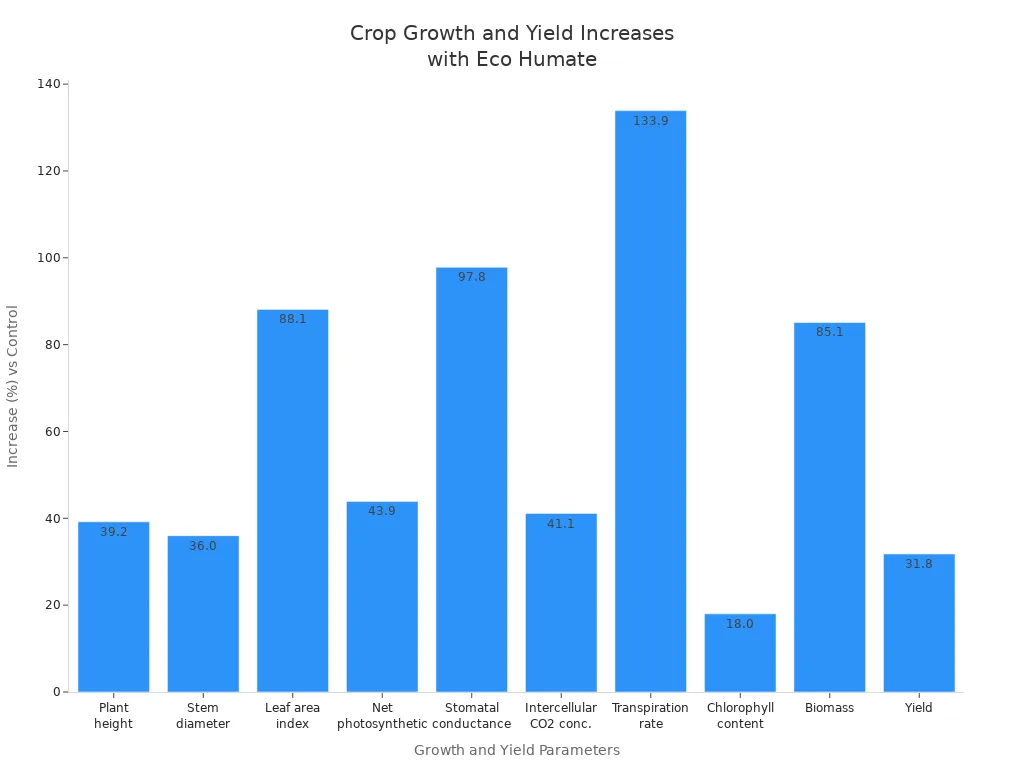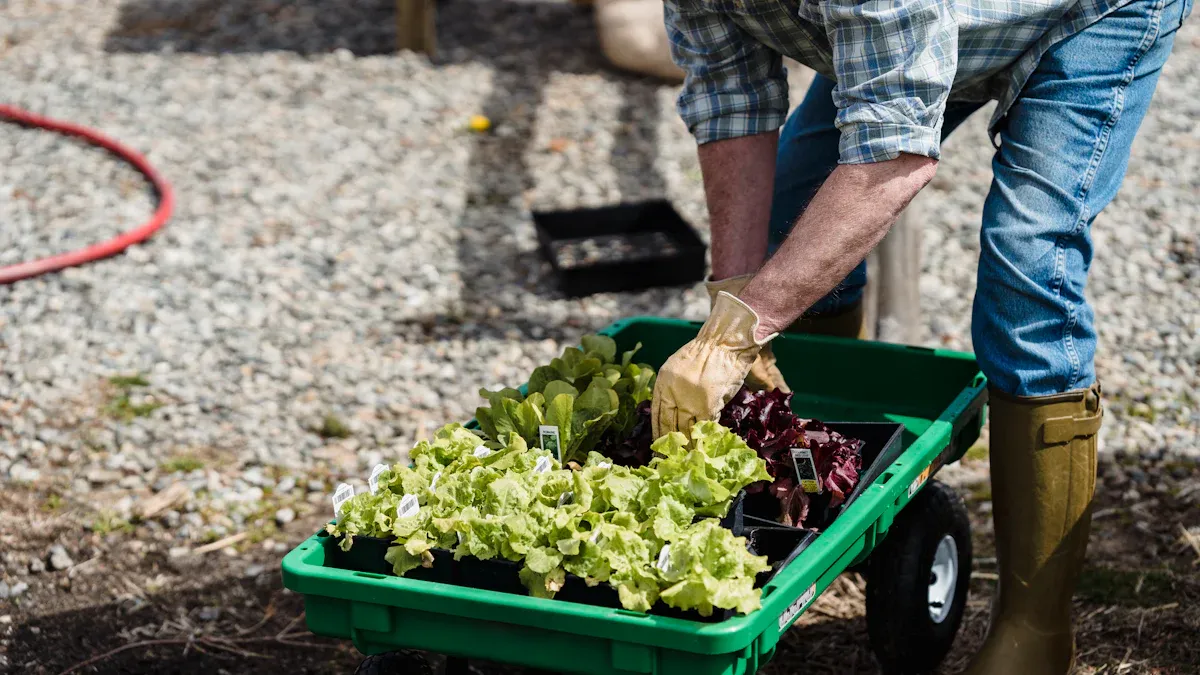Discover the Advantages of Eco Humate for Australian Farmers

Australian farmers often have problems with soil health. These problems include water not soaking in and soil not holding nutrients well. Eco Humate helps by making soil better and crops grow more. Recent glasshouse studies in New South Wales show this. The studies found more microbes in the soil and stronger plants when humic substances are used. Eco Humate makes nutrients easier for plants to get. It also helps keep soil healthy. This leads to farming that is better for the environment. Farmers can notice real benefits from Eco Humate. This is very helpful in Australia’s tough climate.
Key Takeaways
Eco Humate makes Australian soils better by holding more water. It also helps plants get more nutrients. This helps crops grow well, even when the weather is hard.
It helps roots grow strong and keeps soil in good shape. This stops soil from washing away. Plants can get water and nutrients more easily.
Eco Humate helps plants take in more nutrients, like nitrogen and phosphorus. Fertilisers work better, so farmers use fewer chemicals.
The product helps good microbes in the soil grow. These microbes protect plants from sickness and keep the soil healthy.
Farmers who use Eco Humate often get more crops. They spend less money on supplies. Their farms make more money over time.
Eco Humate helps keep rivers and lakes clean by stopping chemicals from washing away. It also helps farmers look after the land for the future.
It is simple to use. You can put it on the soil, mix it with water, or spray it on leaves. It works with most fertilisers and soil helpers.
Many Australian farmers say Eco Humate really helps. They see better soil, stronger plants, and farms that can handle tough times.
Eco Humate Overview
What Are Humates?
Humates are made from old plants and animals that have broken down. They have a lot of humic and fulvic acids, which are full of carbon. Farmers use humates to make soil better and help it keep water. Humates also help plants get more nutrients from the soil. They make roots grow stronger and help good microbes in the soil. Studies show humates work even better with helpful bacteria. This helps plants take in nutrients and grow strong roots. Humates help crops deal with tough times like drought or bad soil. They let farmers use less fertiliser and pesticide. This makes farming better for the environment and gives better crops.
Tip: Humates help plants take in more nitrogen. They also help legumes get more nitrogen, so plants grow better and give more food.
How Eco Humate Works
Eco Humate is a strong liquid that helps soil. It has humic acid, fulvic acid, silica, coconut wetting agent, kelp, blackstrap molasses, amino acids, and minerals. All these things feed plants at the roots and fix damaged soil. Eco Humate adds more carbon to the soil. This makes soil hold water and nutrients better. It also helps soil keep nutrients for longer. Eco Humate works well with lime, gypsum, and fertilisers. When used with fertilisers, it helps plants use nutrients better and stops them from washing away. It also helps keep soil pH steady and lowers salt stress. This is important for Australian soils, which often have salt and acid problems.
Mechanism | Description |
|---|---|
Adds more organic matter and carbon, helps soil stick together and keep water | |
Nutrient availability and retention | Keeps pH steady, helps plants take in nitrate, stops nitrogen loss |
Microbial activity promotion | Helps good microbes in soil break down nutrients |
Phytohormone-like activity | Makes roots grow and helps plants use food |
Suitability for Australian Soils
Eco Humate works well in many Australian soils. It helps soils that are acidic, sodic, or do not let water in. Studies show potassium humate from Victorian brown coal helps soil stay together. Small amounts work for acidic soils. More is needed for sodic soils. Eco Humate makes clay–humate mixes and covers soil to protect it. This stops soil from washing away and keeps it healthy. Experts say humates help soil hold more water and nutrients. This makes fertilisers work better and helps plants get more food. Eco Humate is made in Victoria from Australian Leonardite. It is known for being reliable and working well. Farmers in Australia have seen good results in many crops and soils.
Note: Pick a certified and tested humate like Eco Humate. This gives steady results and helps farmers care for the land.
Physical Benefits

Eco Humate gives big help to Australian farmers. It makes soil better in many ways. Many soils in Australia have trouble with water and structure. Eco Humate fixes these problems. It helps crops grow well, even when the weather is tough.
Water Retention
Soil in Australia dries out fast. Eco Humate helps soil keep more water. Humic acid is the main part of Eco Humate. It helps soil form bigger clumps called macroaggregates. These clumps hold water for plants. Sandy loam soils often do not hold water well. Eco Humate helps these soils keep more water and nutrients. Plants can get water for longer, even when it does not rain much.
Drought Resistance
Drought can hurt crops and lower yields. Eco Humate helps plants live through dry times. It makes soil better at fighting drought. Studies show humic acid helps plants work better during drought. Plants with Eco Humate have stronger defences against stress. They make more antioxidant enzymes to protect themselves. This keeps crops healthy and growing, even with little water.
Reduced Irrigation
Farmers using Eco Humate often need less water. Soil holds water near the roots for longer. This means less watering is needed. Using less water saves time and money. It also saves water, which is important in Australia’s dry weather.
Tip: Better water holding helps plants grow. It also helps farmers use water wisely.
Soil Structure
Good soil structure is important for crops. Eco Humate makes soil less packed and more open. Humic acid lowers soil bulk density and makes more spaces in soil. This helps roots grow and lets soil hold more water and nutrients.
Root Growth
Eco Humate helps roots grow bigger in many crops. Studies show humic acid makes plants have larger root systems. These roots go deeper to find water and food. Strong roots help plants grow better and give more crops. In tests, crops with Eco Humate had stronger and bigger roots than others. Better roots are important for healthy plants and good harvests.
Erosion Control
Soil erosion can take away topsoil and nutrients. Eco Humate helps stop soil erosion. It makes soil particles stick together in strong groups. These groups do not wash or blow away easily. Tests show humic acid makes soil more stable and less packed. This lets water soak in instead of running off. Strong roots from Eco Humate also hold soil in place and stop erosion.
Note: Farmers using Eco Humate see better soil, stronger roots, and less erosion. These changes keep the land safe and help farms do well for a long time.
Chemical Benefits
Eco Humate gives important chemical help to farms in Australia. It helps crops get more from the soil. Fertilisers work better with Eco Humate. These changes make plants healthier and give better harvests.
Nutrient Uptake
Plants need nutrients from the soil to grow strong. Eco Humate helps roots take in more nutrients. Studies show potassium humate, like Eco Humate, helps crops like maize, tomatoes, and beans. These crops have stronger roots and more green leaves. They also grow better. In spring wheat, humic substances help plants get more nutrients, even when rain is low. This makes plants taller and gives more crops.
Nitrogen Efficiency
Nitrogen is very important for plants. Eco Humate helps plants use nitrogen better. It slows down nitrogen loss from the soil. More nitrogen stays for crops to use. Research shows humic substances raise nitrogen in plants. They also help plants use nitrogen better. Farmers get better results with the same fertiliser. Eco Humate also helps soil microbes that move nitrogen around. This makes the process work even better.
Phosphorus Availability
Phosphorus can get stuck in Australian soils. This happens in soils with high pH or lots of calcium. Eco Humate helps by lowering soil pH. It makes phosphorus easier for plants to use. This stops phosphorus from getting stuck and helps plants get more. Studies show humic substances help plants take up more phosphorus. Plants grow better with this help. This is important for soils with high phosphorus buffering index and high aluminium. In these soils, phosphorus is hard to get.
Fertiliser Effectiveness
Farmers want their fertilisers to work well. Eco Humate helps fertilisers work better. Plants take up more nutrients and soil gets healthier. Less fertiliser is wasted and more goes to crops.
Reduced Chemical Use
Eco Humate lets farmers use less chemical fertiliser. Crops still grow well. Potassium humate and fulvic acid make soil better. They help plants take up potassium and trace elements. Crops need less added fertiliser. Studies show using humic substances with fertilisers means less is needed. This saves money and helps the environment.
Tip: Using Eco Humate with fertilisers can help farmers stop using more chemical fertiliser. This helps make farming better for the planet.
Potassium and Trace Elements
Potassium is very important for healthy plants. Eco Humate works as an organic potassium fertiliser. It raises the amount of potassium in the soil. It also helps plants take up trace elements. These are needed for growth and strength. Research shows potassium humate makes soil structure better. It also increases good microbes in the soil. These microbes help plants get more nutrients. In rice, seeds treated with potassium humate grow better and are stronger, even when stressed. This helps crops stay healthy and means less extra fertiliser is needed.
Eco Humate helps farmers use nutrients better and makes fertilisers work harder. It helps plants take up more nutrients, use less chemicals, and get more food. These benefits help Australian farmers grow better crops and look after their land for the future.
Biological Benefits
Eco Humate gives big help to soil health. It helps keep the balance in farming systems. Many Australian farmers have soils with few microbes. Eco Humate helps bring back these soils. It helps the soil microbiome grow and stay healthy.
Microbial Activity
Soil Microbiome
Eco Humate has humic substances that wake up microbes in soil. These substances bring in good bacteria like Chloroflexi, Acidobacteria, and Actinobacteria. These microbes break down old plants and move nutrients around. This makes soil better and helps plants grow. Studies show humic acid and sodium humate change the mix of bacteria and fungi near roots. In cucumber crops, this means less bad fungi like Fusarium oxysporum. Farmers see plants that look healthier and have fewer signs of disease. The soil microbiome gets more types of microbes and stays steady. This helps plants get more nutrients and grow strong.
Disease Suppression
A healthy soil microbiome helps plants fight off diseases. Eco Humate helps good microbes grow and beat the bad ones. These good microbes help plants build their own defences. Studies show humic substances make plants bigger and lower disease signs. Farmers see fewer cases of Fusarium wilt and other soil diseases. The better microbe network makes it hard for bad organisms to live in the soil. This means crops are better and yields are higher.
Note: Eco Humate helps farmers keep crops safe. It does this by making the soil microbiome better and helping plants fight disease.
Plant Health
Growth and Resilience
Eco Humate helps plants grow in many ways. Potassium humate makes more phytohormones and helps plants fight stress. These changes help plants stay strong and grow well. Research on Arabidopsis thaliana shows potassium humate turns on genes for metabolism and stress. Plants make more proline and sugars. These help protect them when times are hard. Eco Humate also makes soil richer and helps roots get more nutrients.
Farmers see bigger roots, more flowers, and better smells in crops like Rosa rugosa. The soil near roots gets more nutrients and good microbes. This helps plants get better and stronger. After soil fumigation, Eco Humate helps good microbes come back. This lowers the risk of disease and helps plants grow fast.
There is a clear link between microbe health and crop yields. Data from field trials show Eco Humate soils have taller plants, thicker stems, bigger leaves, and better photosynthesis. Yields go up by over 30%. Biomass goes up by more than 80%. These results show Eco Humate is good for Australian farmers.
Parameter | Increase (%) Compared to Control | Relevance to Microbial Health and Crop Yield |
|---|---|---|
Plant height | 39.2% | Shows better growth from soil and microbes |
Stem diameter | 36.0% | Means stronger plants from good soil |
Leaf area index | 88.1% | Bigger leaves mean more photosynthesis |
Net photosynthetic rate | 43.9% | Better photosynthesis from healthy microbes |
Stomatal conductance | 97.8% | Better gas exchange from good soil microbes |
Intercellular CO2 conc. | 41.1% | Shows better photosynthesis from microbes |
Transpiration rate | 133.9% | Better water use from healthy soil |
Chlorophyll content (SPAD) | 18.0% | Greener plants from good microbes |
Biomass | 85.1% | More plant mass from active soil microbes |
Yield | Higher yield shows microbes help crops |

Economic Benefits
Increased Yields
Australian farmers get great results with Eco Humate. This product helps crops grow stronger and give more food. Many tests show Eco Humate makes yields go up in many crops and pastures.
Ryegrass shoots grew 150% more on oxisol soils with humate.
Italian ryegrass and lucerne grew much better with Australian lignite-derived humates.
Pasture dry matter went up by 41% over urea alone in spring 2015–16 at 20% humate rates.
Adding humate always gave higher yields than urea, with 12% to 20% more in the last season.
Humate helps soil microbes work better. This improves nitrogen use and keeps pasture growing well.
Farmers see bigger yields and more crops after using Eco Humate in their soil plans. These good changes help farms do well and make crops better.
Lower Input Costs
Eco Humate helps farmers spend less on fertiliser and water. Old-style fertilisers, like nitrogen salts, can hurt soil carbon and make soil hold less water. This means farmers pay more for fertiliser and water. Eco Humate has humic substances that help good soil microbes, make nutrients easier to get, and make soil stronger. These things help soil keep water and move nutrients around by itself. Farmers need less chemical fertiliser and less water. Building soil carbon and waking up soil biology with Eco Humate means lower costs for fertiliser and water over time.
Tip: Using Eco Humate often helps farmers save money and keep soil healthy for future crops.
Long-term Profitability
Using Eco Humate often helps farms do well for many years. Healthy soil gives better crops every year. Farmers who use Eco Humate see crops and yields get better all the time. Lower costs mean more profit for the farm. Eco Humate helps farms handle drought and poor soil better. This makes farms steady and lets farmers plan ahead.
A simple Eco Humate routine can protect soil, raise yields, and help Australian farms grow more food.
Ecological Benefits
Waterway Protection
Eco Humate helps keep rivers and streams clean. It stops chemicals from washing off farms. The soil holds on to nutrients better with Eco Humate. This means less fertiliser and fewer chemicals get into water. Humate products grab onto toxic metals and bad compounds in the soil. This lowers the chance of pollution. Cleaner water helps animals and keeps nature healthy. Farmers see clearer water running off their fields. They also notice less pollution after using Eco Humate. Because it is organic and breaks down easily, it does not hurt fish or other water life.
Eco Humate works like a natural filter. It catches bad stuff before it gets to rivers and streams.
Soil Conservation
Australian farmers often have problems with soil getting worse. Eco Humate helps save soil by making it stronger and adding more organic carbon. Studies show Eco Humate, made with special filters, is a green fertiliser. It helps plants grow and stay healthy without causing harm. The way it is made gives lots of humate and takes out extra salts. This keeps soil in good shape. Humate wakes up microbes in the soil. These microbes break down old plants and give out nutrients. Stronger soil does not wash away as easily. Topsoil stays in place. Farmers see soil holding more water and crops that can handle tough times. This helps save soil for the future.
Sustainable Farming
Eco Humate is important for farming that cares for the land. It makes soil better without needing lots of chemical fertilisers. Farmers see healthier plants covering the ground and roots that go deeper. Humate helps seeds start growing and roots get strong. This means plants grow well. The product helps the land hold water, move nutrients, and keep plants strong. Farmers get more crops and spend less money. Eco Humate is safe for animals and bees because it is not toxic. By using Eco Humate, farmers help bring back good soil and keep farming going for many years.
Eco Humate makes soil better and helps plants take in more food.
It helps roots grow deep and supports plants that cover the ground.
Humate helps plants deal with dry weather, salty soil, and heat.
It grabs and removes toxins, making soil cleaner.
Farmers can use up to half as much mineral fertiliser, which is good for the land.
Eco Humate is a good choice for farmers who want to look after nature and keep their land working well.
Application and Success

How to Use Eco Humate
Farmers have a few ways to use Eco Humate. It works for both big farms and gardens. You can use soil drenching, fertigation, or foliar spraying. Each way is good for different crops and farm types.
Common Application Methods:
Soil Drenching: Farmers pour Eco Humate near the roots. This is good for vegetables, fruit trees, and vines.
Fertigation: Some farmers mix Eco Humate with water for irrigation. This spreads it across big fields.
Foliar Spraying: Spraying Eco Humate on leaves helps plants get nutrients fast. This is helpful when crops are stressed.
Recommended Dosage Table:
Crop Type | Application Rate | Timing |
|---|---|---|
Broadacre crops | 5–10 L/ha | At sowing or early growth |
Pasture | 5–10 L/ha | After grazing or rain |
Vegetables | 2–5 L/ha | At planting and mid-season |
Orchards/Vines | 5–10 L/ha | Pre-flowering and fruit set |
Farmers should mix Eco Humate with enough water to cover the soil. They can use it with most fertilisers, lime, or gypsum. Always check if it mixes well with other products first.
Tip: Use Eco Humate early in the season for best results. Using it more than once keeps soil healthy all year.
Australian Case Studies
Many farmers in Australia have seen good results with Eco Humate. Their stories show how it works on real farms.
Wheat Grower, New South Wales:
This farmer used Eco Humate at sowing and again later. He got 15% more yield and stronger roots. The soil kept more water, which helped when it was dry.Dairy Pasture, Victoria:
A dairy farm used Eco Humate after cows grazed. The grass grew 20% more. The farmer saw greener grass and fewer empty spots. Soil tests showed more organic carbon and better soil.Vegetable Producer, Queensland:
This grower used Eco Humate with irrigation water. Tomato plants grew faster and made more fruit. The farmer used less chemical fertiliser and saved money.
Note: Farmers all over Australia say their soil is better, crops are healthier, and yields are higher with Eco Humate. These results match what research shows.
Farmers can try Eco Humate on a small area first. Using it often helps soil stay healthy and makes farms do well for a long time.
Eco Humate helps soil get healthier and crops grow stronger. It also supports farming that looks after the land. Farmers notice they get more crops, use water better, and spend less money on supplies. The table below lists the main benefits and tips from experts for better soil and more crops.
Practice Area | Key Benefits & Data Points | Expert Recommendations & Notes |
|---|---|---|
Soil Health & Microbial Regeneration | Soil organic matter goes up by 0.4% each year. Farmers use 15% less synthetic nitrogen after two seasons. Soil diseases drop by 25% because there are more good microbes. | Experts say to use methods that help soil life, like adding compost and keeping roots in the ground all year. This builds humus and stores carbon. |
Cover Crops & Root Zone Dynamics | Soil organic carbon rises by 0.2% from 1.2 t/ha more plant material. Water soaks in 30% better within a year. Yields can go up by 18% in the next crop. | Experts suggest mixing different cover crops and changing them to protect soil and bring in more types of plants and animals. |
Compost & Vermicast Applications | There are 10⁶ CFU/mL more helpful microbes. The humic part of soil goes up by 25% after one season. Farmers use about 20% less fungicide. | Use compost and vermicast teas at the right time to help good microbes grow and move carbon around. |
Biochar & Mineral Amendments | Cation exchange capacity goes up by 20% in 18 months. Nitrate leaching drops by 35%. Roots grow 5 cm deeper in sandy soils. | Use good biochar and mineral mixes to help soil keep nutrients and let roots grow better. |
Regenerative Nutrition & Feedback | Brix in leafy crops goes up by 12% over 2–3 seasons. Phosphorus uptake is 22% better with less fertiliser. | Experts say to test plant sap and leaves to give crops the right food and keep them healthy for longer. |
Systems Thinking & Implementation | Farmers can save up to 40% on supplies by year three. Profit margins go up by 1.6 times. Farms look better for markets that care about the environment. | Experts say to change the whole farm step by step, thinking about nature and money, to make farming strong and profitable. |
Farmers can talk to local agronomists or try Eco Humate on a small part of their farm. This helps them see quick and long-lasting results.
FAQ
What is Eco Humate made from?
Eco Humate has humic acid, fulvic acid, silica, coconut wetting agent, kelp, blackstrap molasses, amino acids, and minerals. These come from nature. They help soil and plants get stronger.
How often should farmers apply Eco Humate?
Farmers use Eco Humate when they plant seeds or when crops start to grow. Some use it again after rain or after animals eat the grass. Using it often keeps soil healthy and helps crops all season.
Is Eco Humate safe for animals and bees?
Eco Humate does not hurt animals or bees. It has organic ingredients. Farmers can use it near cows, sheep, and bees without worry.
Can Eco Humate mix with other fertilisers?
Eco Humate mixes with most fertilisers, lime, and gypsum. Farmers should check if it works well with other products before mixing. This helps crops and soil get the best results.
Does Eco Humate help during drought?
Eco Humate helps soil keep more water. Plants can get water for longer. Farmers see crops stay healthy even when there is little rain.
What crops benefit most from Eco Humate?
Eco Humate works for many crops like broadacre crops, pastures, vegetables, orchards, and vines. Farmers see better growth and more crops in many types of plants.
How does Eco Humate support soil microbes?
Eco Humate gives food to good microbes in the soil. These microbes break down old plants and give out nutrients. Healthy microbes help plants grow and fight off disease.
Tip: Farmers can ask local agronomists for help with using Eco Humate on their crops.
See Also
Advantages And Applications Of Humic Acid Across Australia
Effective Ways To Utilise Humate For Animal Wellbeing
Methods To Enhance Rice Growth Using Humate Fertiliser
Comparing Humic Acid And Chemical Fertilisers For Sustainability
Insights Into Potassium Humate Applications In Indian Farming
